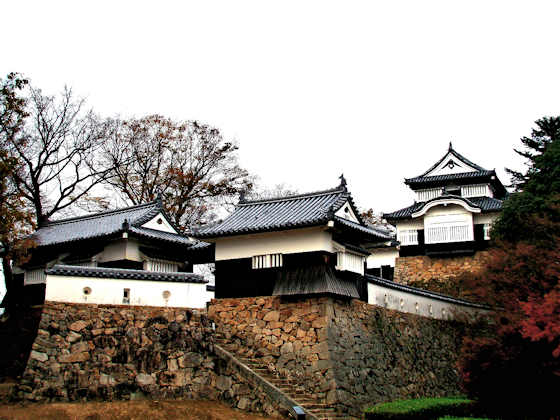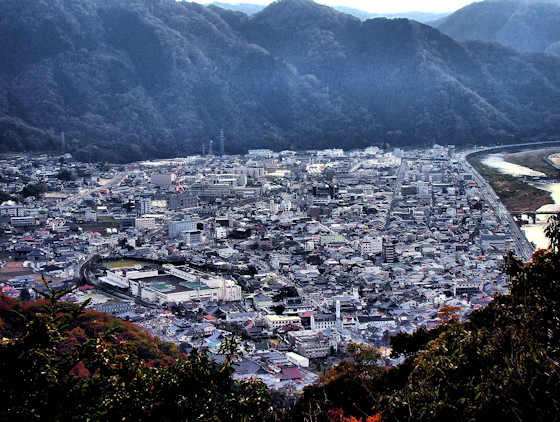Tuesday, February 16, 2010
Plastic Shimenawa
Shimenawa, the sacred ropes demarcating sacred space, are traditionally made of rice straw.
In recent times plastic has started to be used sometimes. It has the advantage that the shimenawa needs replacing less often.
But in the climate of japan, even plastic is susceptible to mold! A lot of the plastic shimenawa are simply made from standard polypropolene rope.
I've seen a few made from a different kind of plastic as well.
Some people think that it is wrong to use plastic for these sacred objects. Rice straw traditionally had many uses, and nowadays so does plastic, so It seems natural to incorporate it.
Labels:
shimenawa
Monday, February 15, 2010
Next Years Firewood
One of the smartest things I ever did was put in a woodstove. Combined with the insulation and draughtproofing I've done it has meant that essentially my heating bill for the past 6 winters has been zero.
Even before this winter is over I am stacking the firewood for next winter. So, where do I get all this free wood?
Just had a 2 ton truckload of posts and beams from a house being demolished. The building company have to pay to dump all the wood at a site 10K away, so they are only too happy to give it us for free. It's cedar, which is not the greatest firewood, it burns hot and fast, but sometimes thats useful.
Before they demolished the house we went in and took out some nice double-glazed windows and some double doors which will fit nicely in my house. Some of the 4 by 4's I will denail and trim and use for construction too.
For good firewood you need a nice hardwood, and we are getting that from our local shrine. They have just cut back a lot of the trees on the hill, and as they can't afford to pay to have it taken away they too are happy that we will. There is a lot of Kashi, white oak, which is excellent firewood, and a lot of Tsubaki, Camellia, which I don't know about as firewood, though I've read that it is cut for firewood in some places.
Labels:
freeganism,
Shimonohara
Saturday, February 13, 2010
Chuya Nakahara's hat
Recently someone described me as having a fetish for manhole covers. Not sure if it's true and accurate, but I do find them a fascinating way to learn about places.
For anyone who truly has a fetish for them, Yuda Onsen in Yamaguchi Prefecture is the place to go. In this small town they have dozens and dozens of different designs.
This group of four all show Chuya Nakahara' hat. He was a local boy who made quite a name for himself as a poet during the Taisho period. He was influenced by Dadaism and later French Symbolism, and though not so well known outside Japan was known for his avant gardeism and bohemianism, though apparently he is most wull known for the hat he wore.
He died young at only 30 years of age. There is an excellent site in English on him here
The town has a small museum containing his manuscripts and other materials from his short life.
Labels:
chuya nakahara,
drainspotting,
manhole,
Museum,
poet,
yamaguchi,
yudaonsen
Friday, February 12, 2010
Red hats & bibs: around the trees
The last time I visited Tachikue Gorge I was really lucky to get some quite magical light.
As well as along the cliff, some of the 1,500 statues are placed around some of the huge trees there.
There may be times during the year when the gorge gets visitors, but each time I've been there I have been the only person there.
The first time I visited I had walked for three days over the mountains from Iwami and down the Kando River.
Buses from Izumo Station, 8k away, stop at several point along the gorge.
Thursday, February 11, 2010
Asia Pacific Import Mart
The Asia-Pacific Import Mart and West Japan General Exhibition Hall are located just north Of Kokura Station in Kitakyushu and is part of the redevelopment of the old indistrial/port area.
It's part of Kitakyushu's FAZ (Foreign access zone) an attempt, somewhat successful, to forge stronger links between North Kyushu and the mainland of Asia.
It was finished in 1998 and was designed by Nikken Sekkei.
The AIM is home to a variety of restaurants and shops featuring products from the Asia Pacific region.
Labels:
Architecture,
kokura,
kyushu,
nikken sekkei
Wednesday, February 10, 2010
The view from the highest castle in Japan
Getting up to Bitchu Matsuyama castle, Japan's highest, is not very easy. There is no public transport up the steep road, though you can drive or take a taxi three quarters of the way up, there is still a steep climb to the top. From the bottom allow a good hour to walk up.
The view down to Takahashi, about 1,000 feet below is worth the climb though.
Takahashi and its castle doesn't get a lot of visitors as its not on the Shinkansen, but its worth a visit.
As well as the castle there are a lot of Edo-period buildings in one section of town and a wonderful zen garden. Nearby is a wonderful Tadao Ando building housing a large art museum. There's lots of signs in English.
The rest of Takahashi is a a fairly typical "cookie cutter" Japanese town.
Its located on the JR Hakubi line which connect Okayama City with Yonago, Matsue and Izumo.
Tuesday, February 9, 2010
The highest castle in Japan
Labels:
bitchu matsuyama,
castle,
okayama,
takahashi
Monday, February 8, 2010
Red hats & bibs: cliffside
Buddhist statues wearing red hats and bibs can be found all over Japan. In wayside shrines and altars there will be alone or in small groups. In larger temples there may be many of them in lines.
In Tachikue Gorge on the Kando River a few k south of Izumo City, there are hundreds of them arrayed along a cliff for about 500 meters.
There are 1,000 statues of various buddhas, and 500 statues of Buddhas disciples.
This area was a centre for Yamabushi until Shugendo was outlawed in early Meiji.
Buses from Izumo Station stop along the gorge.
Saturday, February 6, 2010
Concrete Wabi Sabi: Virgin tetrapods
Concrete Wabi Sabi: Virgin tetrapods
I like this photo because without any scale reference, one could be looking at something architectural, a stadium maybe.But in fact, it's just a line of new tetrapods waiting to go in place to "protect" the riverbank.
New concrete can have an aesthetic quality, in my opinion.
There are tetrapod production sites all over the place. Mostly they are made in situ, you just need the molds and a constant stream of cement trucks.
I haven't been able to find the numbers, but I'm willing to bet that Japan leads the world in the number of cement trucks per capita.
Friday, February 5, 2010
Japan from the air.
Flying back into Japan on Wednesday I was able to get a few decent shots. This first one is somewhere in north Kyushu.
Kyushu has a lot of active volcanoes, and I've studied maps to try and find which one this is, but couldn't be sure. If anyone knows, please let me know.
Kochi City on the south coast of Shikoku.
Somewhere in eastern Shikoku.
In the middle of Awajima, descending to land at Kansai Airport.
Subscribe to:
Posts (Atom)



















